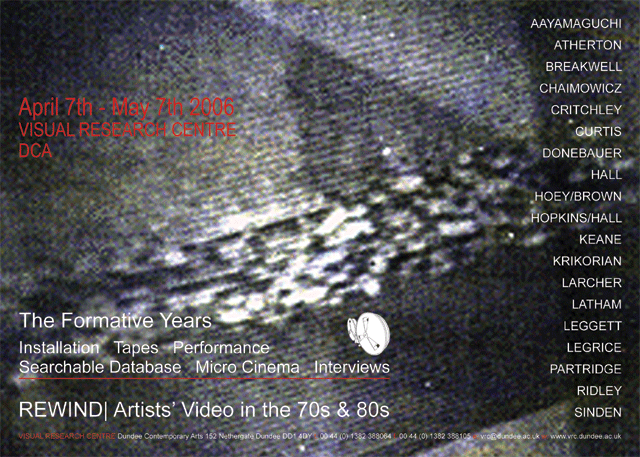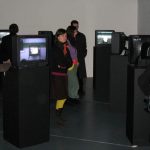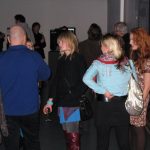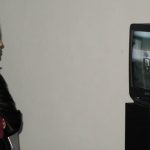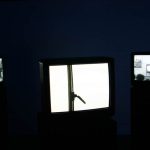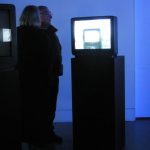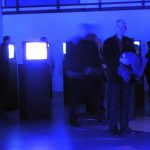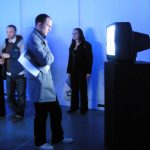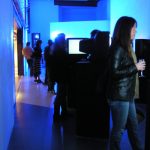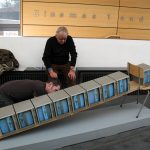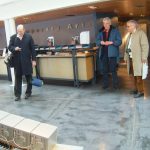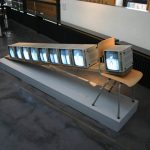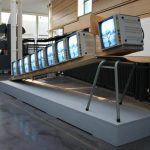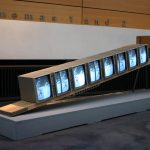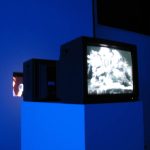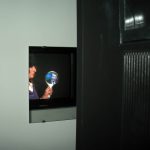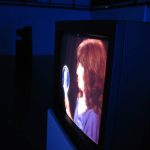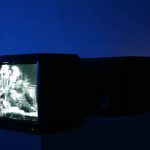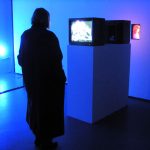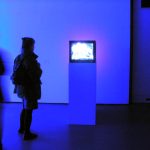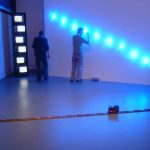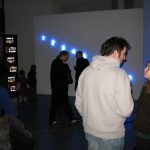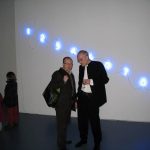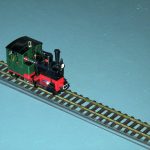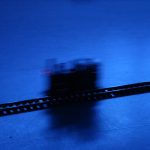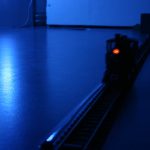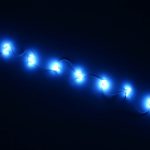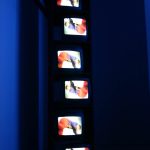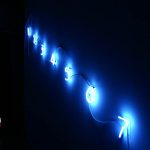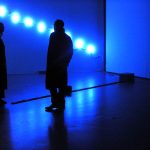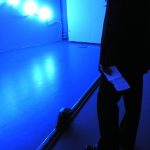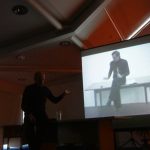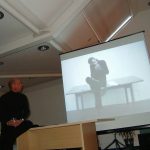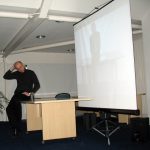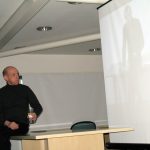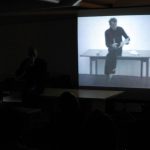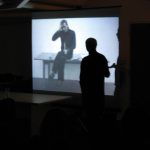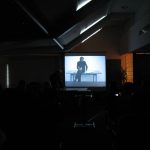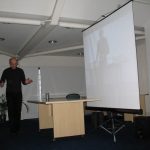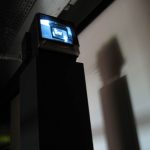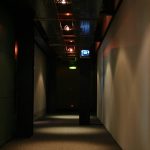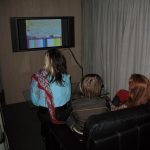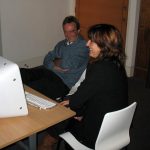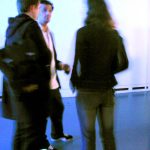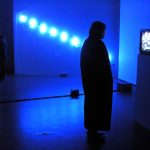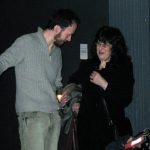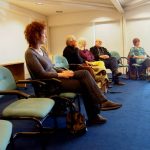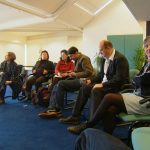Visual Research Centre and Dundee Contemporary Arts
7th April 2006 - 7th May 2006
The Soft Launch had a number of components including workstations featuring the Database at the heart of the REWIND research resource, with interviews, ephemera, articles and other information on all of the artists who have participated in REWIND thus far.
It included:
Restaged Installations
7 TV Pieces by David Hall, 1971
Behold Vertical Devices by Tony Sinden, 1974
Vanitas by Tamara Krikorian, 1979
Demolition/Escape by Tina Keane, 1983
Monitor by Stephen Partridge, 1974
Public Launch Lecture
Professor Sean Cubitt and Dr Jackie Hatfield April 7th 2006
Performance of In Two Minds by Kevin Atherton
7th April 2006, 7pm DCA
8th April 2006, 12pm DCA
Round Table Discussion
8th April 2006, 3pm DCA, with Prof Stephen Partridge, Dr Jackie Hatfield, Prof Jane Prophet, Adam Lockhart, Prof Sean Cubitt, Prof Ian Christie, participating artists and special guests.
Click here to view more information and documentation from the exhibition.
Introduction to Soft Launch by Prof Stephen Partridge
Throughout the 1990s a deepening concern developed about the early works produced in the UK using film, video, performance and media installation. Because of their ephemeral nature and the unpredictable state of the technology, video works were in danger of disappearing altogether. This was not just to do with the fragile and decaying nature of the early technological media, but also because so little had been written down about the work. The hegemony of text in our culture can distort histories, leaving only hagiographies to compete and contradict one another. In early 2002 I was approached by Laura Mulvey, who had herself become concerned about early video.
She suggested that I might be well placed to develop a substantial research project to address both the issues of conservation and to write/record – from primary sources – an intelligible history of the form. I am deeply grateful for the advice and information I received over the following year, whilst developing the project from a great number of distinguished artists, scholars, curators, writers and arts administrators. REWIND is also very fortunate in having attracted a team of dedicated researchers and advisors of outstanding ability. Finally I would like to dedicate this launch event of REWIND to the pioneers of the form, who having left their mark and are no longer with us, including Ian Breakwell, John Latham, Stuart Marshall, Elsa Stansfield, and Nam June Paik.
David Hall – TV Interruptions (7 TV Pieces) Installation version 2006
In 1971 David Hall made ten TV Interruptions for Scottish Television which were broadcast, unannounced, in August and September of that year coinciding with the Edinburgh Festival. The selection of seven of the ten was later issued as 7 TV Pieces, the most well known. The works, although made on film are indisputably concerned with television and by proxy, video. This was the first time these works were exhibited as an installation. The installation was acquired by TATE in 2016 as part of the permanent collection.
Tony Sinden – Behold Vertical Devices (1974)
“Behold is a kind of homage to Edweard Mubridges pioneering Motion Picture Studies (1878/85). Looking back it does seem to mark a significant shift in my practice, moving from single screen work to expanded cinema and installation in the gallery context. At the time I did not own any video equipment, it was too expensive, usually you had to beg, steal or borrow what you wanted to use. I saw the gallery more as a laboratory not an end point, a place to experiment and make new connections”. Extract from Judith Winter in conversation with Tony Sinden: Everything Must Go – Installation, Video and Film National Touring catalogue published 2003.”
Vanitas – Tamara Krikorian 1979
The idea of using the ‘Vanitas’ theme in Krikorian’s work came originally from a painting which she saw in the Ashmolean museum in Oxford. The title of the 17th century painting is ‘Allegory of Justice and Vanity’ in which a woman is seated holding a mirror, which is facing the spectator. A number of still life objects including a skull and a candlestick denoting the transience of life are reflected in the mirror. In other Vanitas paintings, the self-portrait of the artist is also seen as a symbol of transience. Some Dutch ‘memento mori’ paintings would have a portrait on the front and a still life on the back. In Vanitas or An Illusion of Reality, the two TVs are placed back to back, splitting the ‘vanitas’ subjects with a still life with butterflies and bubbles and flowers on one screen and a self portrait of the artist holding a mirror reflecting the changing faces of the newsreaders on the other. The newsreaders can be seen as 20th century icons. The work relates to the ephemeral nature of TV itself.
Tina Keane – Demolition/Escape 1983
“Demolition / Escape provides a rich texture of signifiers which the viewer can combine in various ways to create several layers of meaning. The work is rhythmically constructed from multiples of the number three; each art of the spatial triangle visually echoes this repeated unit. Three is a symbolic number referring, among other things, to the ages of man in the riddle of the Sphinx in the Oedipal myth… Her version of the song, however, is sung somewhat ironically by the innocent voice of a girl. It is among the work’s strength that, through subtle juxtapositions, it provokes without sentimentality the memory of our own childhood in unison with issues of adulthood.” Jean Fisher from Artforum, May 1983.
Kevin Atherton – In Two Minds, Performance
In two minds is a two monitor installation first exhibited in the Serpentine Gallery, London in 1978. This work consisted of Atherton on one video monitor asking questions of himself on the other monitor. The questions, typically of that time, largely address the nature of the piece itself. At time of making the piece he had no intention of using it beyond the Serpentine show, the rough and ready state of the black and white tapes attest to this. However, the ‘open’ or ‘incomplete’ nature of the work allows him to ‘re-enter’ it and create a new version, where as a 55 year old man he can answer questions put to him by his 27 year old former self.
As a complement to the first work the ‘future’ version of In Two Minds consists of Atherton as a fifty five year old man-asking questions of his eighty one year old self. This is done through the use of make up and by acting himself as an old man. The basic principle of real time, so enshrined in the work from the seventies, is now broken. This and other transgressions that span a period of fifty-four years, twenty-six of which are yet to occur, is the subject of the work. The virtual nature of predicting the future also allows Atherton to create fictional art works, make public his career aspirations, and to imagine how his personal life might pan out.
Stephen Partridge – Monitor 1974
The installation version of Monitor was acquired by TATE in 2016 as part of the permanent collection.
Micro Cinema & Database
Miscellaneous Photographs



